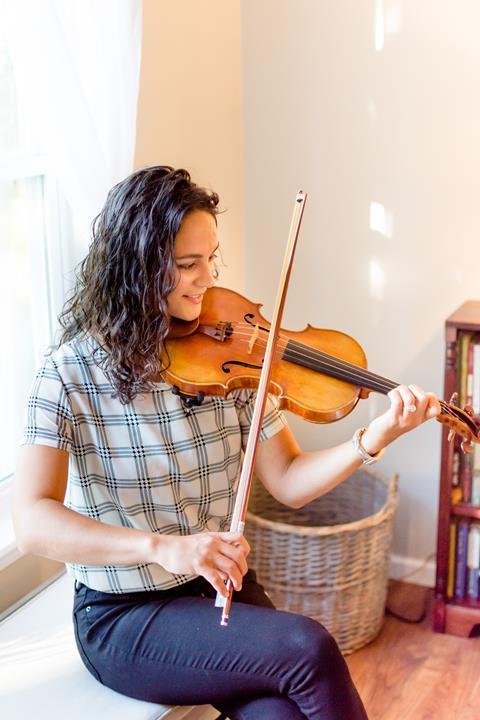Having an awareness and understanding of how the bow arm moves is crucial to achieving a good tone on the violin

Read more Technique articles like this in The Strad Playing Hub
One of the hardest aspects of playing the violin is having good bow control and tone quality. Unfortunately, this can also be difficult to teach. Because so much of bowing is based on body awareness and an individual’s anatomy, it’s not always easy for the teacher to diagnose what’s happening. It’s important for teachers and students to understand the anatomy and function of the bow arm in making a good tone on the violin. While I am by no means an anatomy expert, having a basic understanding of the arm movements involved can give you a place to start.
The upper arm and shoulder are the most complex. They’re in charge of changing strings, holding the bow in place, weight distribution, and the placement of the bow on the string. Because the shoulder is a ball-and-socket joint, it can move in really any direction. Improper alignment or placement of the joint can lead to several different bowing issues. If the shoulder is too far forward or back, the bow will be crooked on the string and may slide causing extra sounds.
Violin students also tend to raise their shoulders up towards their ears as they concentrate on their music. When this happens, they often try to ’relax their shoulders’ by dropping them straight down. But this doesn’t take into account the ball-and-socket joint. If the student’s shoulder is forward when they relax, then it will be pulling on their back muscles in unnatural ways.
The upper arm also controls weight distribution and dynamics. Weight distribution is a huge component of our tone quality. Many times students will try to control this aspect of playing by either pushing into the string (creating a harsh, crunchy tone) or by holding the bow above the string too much (causing a breathy, airy tone). Instead, you need to keep the shoulder stable and allow the weight of the arm to travel down through your index finger and into the bow. You can then adjust the amount of weight and speed to get the sound you want.
Read: The importance of body awareness in violin playing: Rachael Ridge
Read: 6 tips for practising fast passages: violinist Susanna Klein
The lower arm is the simplest part as the elbow joint acts like a hinge. This part of our arm is in charge of pulling the bow across the string by opening and closing the elbow joint. It works together with the upper arm to keep the bow straight on the string and to use its full range of motion. It also controls the speed of the bow which can assist in creating a good tone. A common problem I’ve seen is the upper arm getting too involved in the lower arm’s job. When this happens, it adds a lot of unnecessary movement. It’s important that the upper arm remain a stable foundation for the lower arm to move across the string.
Finally, the wrist and fingers play an important role in smoothing out our tone and controlling the more advanced bow strokes. The wrist should be leaning towards the first finger to allow the weight of the arm to travel through the fingers and into the bow. It also needs to be flexible to use the full range of motion and to smooth out the bow changes.
The fingers of the right hand each have distinct jobs. The thumb should be curled and aligned behind the middle two fingers to create the core of our bow hold. If the thumb is locked or tense in any way, it throws off the flexibility and stability of the other fingers. The first finger and pinky have very specific jobs depending on which part of the bow you’re using. The first finger is in charge of transferring the weight of your arm into the stick when you’re using the upper half. The pinky is in charge of counteracting the weight of the bow at the frog to prevent crunchy sounds and to make an even tone in the lower half.
If you’d like to watch the video mini-series I did on this topic, check out my YouTube channel @RachaelRidge. You can also follow me on Instagram @rachael.ridge for more violin education.
Read: Bow holds of the great violinists
Listen: The Strad Podcast Episode #40: Naomi Yandell on teaching beginner bow holds
Read more Technique articles like this in The Strad Playing Hub
The number one source for playing and teaching books, guides, CDs, calendars and back issues of the magazine.
In The Best of Technique you’ll discover the top playing tips of the world’s leading string players and teachers. It’s packed full of exercises for students, plus examples from the standard repertoire to show you how to integrate the technique into your playing.
The Strad’s Masterclass series brings together the finest string players with some of the greatest string works ever written. Always one of our most popular sections, Masterclass has been an invaluable aid to aspiring soloists, chamber musicians and string teachers since the 1990s.
This year’s calendar celebrates the top instruments played by members of the Australian Chamber Orchestra, Melbourne Symphony, Australian String Quartet and some of the country’s greatest soloists.













































No comments yet